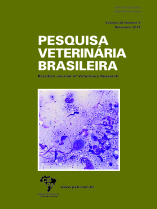 |
|
|
|
Year 2018 - Volume 38, Number 9
|

|
Canine cutaneous mast cell tumors: retrospective study of cases attended by the oncology service at the Veterinary Hospital of FCAV-Unesp, Jaboticabal, from 2005 to 2015, 38(9):1808-1817
|
ABSTRACT.- Souza A.C.F., Pascoli A.L., Ferreira M.G.P.A., Reis Filho N.P., Silva I.C.R., Santos R.R., Faro A.M. & De Nardi A.B. 2018. [Canine cutaneous mast cell tumors: retrospective study of cases attended by the oncology service at the Veterinary Hospital of FCAV-Unesp, Jaboticabal, from 2005 to 2015.] Mastocitoma cutâneo canino: estudo retrospectivo dos casos atendidos pelo serviço de oncologia do Hospital Veterinário da FCAV-Unesp, Campus Jaboticabal, de 2005 a 2015. Pesquisa Veterinária Brasileira 38(9):1808-1817. Departamento de Clínica e Cirurgia Veterinária, Universidade Estadual Paulista, Campus Jaboticabal, Via de acesso Prof. Paulo Donato Castelane, Jaboticabal, SP 14884-900, Brazil. E-mail: anacarolina@ciave.com.br
This study analyzed the cases of cutaneous mastocytomas in dogs seen at the Governador Laudo Natel Veterinary Hospital of the College of Agrarian and Veterinary Sciences (FCAV), Unesp, in Jaboticabal, from 2005 to 2015. The objective was to determine the occurrence of this neoplasm regarding breed, sex, and age, the most affected body parts and observed neoplastic characteristics; the most widely used diagnosis methods, the main histological grades and recommended treatments, to evaluate size changes in relation to lymph nodes, recurrence rate, metastasis and to verify possible associations between the evaluated variables. The clinical files of 192 patients were evaluated. The most affected dogs were of mixed breed (n=46, 23.96%), followed by Boxer (n=40, 20.83%) and Pitbull (n=27, 14.06%). Most of the dogs were females (n=107, 55.7%), aged between 7 and 11 years old (n=120, 62.5%). Thirty-two patients had (16.7%) tumors located in the pelvic limb, followed by thoracic limbs (10.4% n=20). Sixty-five animals had ulcerated nodules (33.9%), of which 96 had firm consistency (50%). Seventy-six animals had multiple nodules (39.6%), and 39.1% of the sample (n=75) had nodules larger than three centimeters. The most used diagnosis method was fine needle aspiration together with histopathology (HT), totaling 39.8% of nodules (n=66), followed by HT in 37.3% of the patients (n=62). Regarding the histological variables, 18 patients had grade I (11.8%), 112 grade II (73.7%), and 22 grade III (14.5%) classified according to Patnaik et al. (1984). According to the classification of Kiupel et al. (2011), 37 cases were classified as high grade (35.2%) and 68 as low grade (64.8%). Statistical association was observed when the presence of solitary/multiple nodules and the histological grade were evaluated according to Patnaik et al. (1984) (P=0.008) and Kiupel et al. (2011) (P=0.004). The nodules with worse prognostic feature were more frequent in animals diagnosed with multiple nodules, regardless of the histological classification used. The presence of multiple nodules in stage II or IV (p<0.001) and recurrence of the disease (p=0.001) was also observed. Regarding the histological classification of Kiupel et al. (2011), there was a statistical association between histological grade and tumor size (p=0.001), consistency (p=0.028) and nodule growth rate (p<0.001), lymph node enlargement (p<0.001) and the treatment used (p=0.002). Nodules larger than three centimeters (56.8% n=21) and fast growing (52.9% n=36%) were more frequent in high-grade tumors. Lymph node enlargement (80.6% n=25) and chemotherapeutic treatment (83.3% n=5) were also associated with patients with this histological grade. According to the classification of Patnaik et al. (1984), breed and sex differed proportionally between the histological groups (p=0.008 and 0.040 respectively), and lymph node enlargement and rapid tumor growth were also associated with histological grade (p=0.002 and 0.001). Almost half of the patients (47.4%) underwent surgical and chemotherapeutic treatment (n=91) while only surgical procedure was performed in 31.3% (n=60) of the patients. Sixty-one animals (31.8%) had enlarged regional lymph nodes (31.8%), and 71.9% of the nodes evaluated had rapid growth. The clinical evolution time of the tumor was less than or equal to one year in 158 patients (82.3%), followed by 1 to 2 years in 25 patients (13%). There were 66 cases (40.5%) of recurrence and 16 (8.3%) of distant metastasis. With this study, it can be concluded that dogs with mixed breed are the most affected by cutaneous mastocytoma in Jaboticabal city, followed by Boxer dogs, with ages varying between 7 and 11 years, with no sexual predisposition observed. It was also concluded that nodules were predominantly non-ulcerated, solitary and smaller than 3 centimeters, that the majority of patients presented grade II mastocytoma according to Patnaik et al. (1984) and low grade according to Kiupel et al. (2011), not being observed in most of them recurrence, lymph node or distance metastasis. The most commonly used diagnosis was fine-needle aspiration associated with histopathology, and in relation to location, nodules were found predominantly in pelvic and thoracic limbs, followed by head and neck. The consistency of the nodules was both firm and soft, and half of the patients underwent the associated surgical procedure of antineoplastic chemotherapy. |
| |
|
|
| |
|
 |